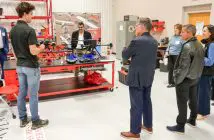
The University of Western Australia (UWA) has announced the successful completion of TeraNet, the first operational optical ground station network in the Southern Hemisphere. This landmark achievement places Australia at the cutting edge of global space communications and national security capability, and occurred when TN-2 achieved first light in September 2025 at the Yarragadee Geodetic Observatory.
Comprising three interconnected ground stations, TeraNet combines advanced optical communications and precision timing technologies into one coordinated system:
- TN-1 (UWA Perth Campus): Supporting investigations into laser communications with spacecraft in deep-space, including upcoming commercial missions to the Moon.
- TN-2 (Yarragadee Geodetic Observatory, WA, 300km north of Perth): Completed in September 2025, this state-of-the-art station incorporates UWA’s world-leading coherent optical technology and adaptive optics system, enabling efficient single-mode fibre coupling. YGO is one of the world’s leading laser ground station sites.
- TN-3 (Mobile Jeep Gladiator Platform): The world’s first fully mobile optical ground station, designed for rapid deployment in disaster-affected regions and delivering quantum-assured timing to strengthen national security.
Together, these three nodes create an unprecedented network capable of enabling communication at data rates thousands of times faster than typical space systems and satellite positioning thousands of times more precise than what is achievable today.
The project is led by Professor Sascha Schediwy, at UWA’s node of the International Centre for Radio Astronomy Research.
“The completion of TeraNet is a transformational milestone,” said Schediwy. “It is the first time the Southern Hemisphere has an operational optical ground station network. By combining permanent facilities with a fully mobile node, we have created a globally unique platform that strengthens international space communications and enhances Australia’s sovereign capability in geodesy, satellite positioning, and national security.”
Head of the Australian Space Agency, Enrico Palermo, applauded the achievement, “TeraNet demonstrates the innovation and impact that results from investing in science and technology.
This network will enhance our ability to connect with spacecraft and future lunar missions, reinforcing Australia’s reputation as a trusted and capable partner in the global space sector.”
TeraNet highlights how investment in major science infrastructure drives technological breakthroughs with real-world applications. The timing capabilities at the core of TeraNet were directly enabled by technologies developed for the Square Kilometre Array (SKA) radio telescope project, which required precise synchronisation of hundreds of antennas across vast
Distances.
By translating this expertise into free-space optical communication, UWA and its partners have created new pathways for ultra-high-speed data transfer, resilient connectivity during natural disasters, and secure timing critical for defence and navigation.
Photo: UWA Display of the Mobile Jeep Gladiator Platform at IAC, 2025, Sydney – Credit: MySecurity Media





